
Rail transport in Angola consists of three separate Cape gauge lines that do not connect: the northern Luanda Railway, the central Benguela Railway, and the southern Moçâmedes Railway. The lines each connect the Atlantic coast to the interior of the country. A fourth system once linked Gunza and Gabala but is no longer operational.
The Rede Ferroviária Federal, Sociedade Anônima was the State-owned national railway company of Brazil created from Brazilian Federal Law #3.115 on March 16, 1957, after several railroads were nationalized by the Brazilian government. However, the railroad did not take full effect until September 30, 1957. The RFFSA linked 42 railways together, creating a regional system composed of 22 railroads. The goal of the RFFSA was to promote and advance the railroad sector of Brazil, creating a north-south-east-west rail network in all five regions of Brazil. But it failed and the RFFSA only served four of the five regions with a north-south rail network win 19 units of the federation of Brazil. By 1999, freight service of the railroad was liquidated and privatized, with the passenger service of the railroad liquidations occurring in 2007.
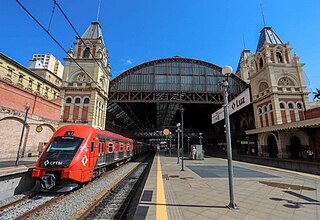
Rail transport in Brazil began in the 19th century and there were many different railway companies. The railways were nationalized under RFFSA in 1957. Between 1999 and 2007, RFFSA was broken up and services are now operated by a variety of private and public operators, including Rumo Logística, Companhia Paulista de Trens Metropolitanos and SuperVia.

Iberian gauge is a track gauge of 1,668 mm, most extensively used by the railways of Spain and Portugal. This is the second-widest gauge in regular use anywhere in the world. Indian gauge railways, 5 ft 6 in, are 8 mm wider.

Companhia Paulista de Estradas de Ferro was a Brazilian railway company located in the state of São Paulo. It was known for its high standard of quality in customer service.

The Moçâmedes Railway is an 860 km railway line in Angola, between Moçâmedes and Menongue. The line is operated by the company Caminhos de Ferro de Moçâmedes E.P. The port city of Moçâmedes was renamed Namibe between 1985 and 2016, so the railway was sometimes called the Namibe Railway. However, the railway company retained its original legal name.

The history of rail transport in Portugal dates from 28 October 1856, when Portugal's first railway line was opened between Lisbon and Carregado: the Companhia dos Caminhos de Ferro Portugueses.
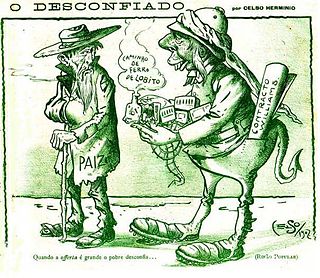
The history of rail transport in Angola began during the nineteenth century, when Angola was a colony of Portugal. It has involved the construction, operation and destruction of four separate, unconnected, coast-to-inland systems, in two different gauges. Operations on three of those systems have been largely restored; the other system has been closed.

The South African Railways Class NG9 4-6-0 of 1915 was a narrow-gauge steam locomotive.
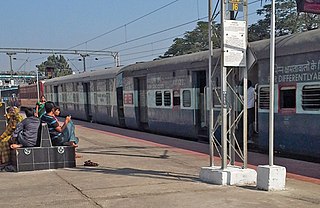
The Guntakal–Vasco da Gama section, or Mormugao Railway, is a railway line connecting the town of Guntakal in Andhra Pradesh and Vasco da Gama in Goa, India. It traverses the Western Ghats and covers a distance of 457 kilometres (284 mi) across Goa, Karnataka and Andhra Pradesh.
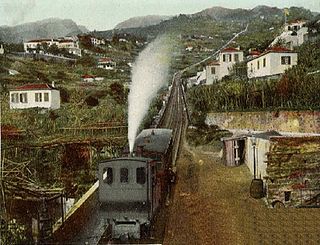
The Monte Railway was a rack railway connecting Pombal, in Funchal, to Terreiro da Luta in Monte, a distance of 3,911 metres. It was built in stages between 1893 and 1912 and ceased operation in April 1943.

Linha da Beira Alta is an international railway line which connects Pampilhosa on the Linha do Norte, close to Coimbra, to the border with Spain, at Vilar Formoso.

Ramal de Aveiro-Mar was a Portuguese railway line, in Aveiro. It connected the metre-gauge Ramal de Aveiro, at Aveiro railway station, to the Canal do Cojo dock, and was used to transport fish to the local market.

Ramal da Lousã is a railway line which connects the stations of Coimbra-B, on the Linha do Norte, and Coimbra, in Portugal. It was opened by the Companhia Real dos Caminhos de Ferro Portugueses, under the name Ramal de Coimbra, on 18 October 1885, and was extended to Lousã on 16 December 1906, and to Serpins on 10 August 1930.

Ramal de Matosinhos, originally called Ramal de Leixões, was a metre-gauge railway line which connected the stations of Senhora da Hora, on the Linha do Porto à Póvoa e Famalicão, to the Port of Leixões, in Portugal. It was built in 1884 to connect the port to the São Gens quarry. Later, it was adapted to passenger and freight transport. Commercial service began on the 6 May 1893. The line was closed on 1 July 1965. In the 2000s, part of the trackbed was used for the construction of Porto Metro Line A.
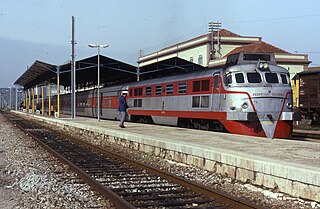
Abrantes Station is a railway station in Abrantes, Santarém, Portugal.

Barreiro is a railway station on the Alentejo Line that serves as a connection between rail services on the South Bank of the Tagus and Soflusa's river transport to Lisbon, Portugal. The first Barreiro station began operating on June 15, 1857, although it was not inaugurated until February 1, 1861. Since it was too far from the river pier, a new station was built and inaugurated in 1884. This station included an important workshop hub, which underwent extension work during the 1900s, but the facilities were becoming insufficient for the demand by the following decade. However, political and social instability, which was reflected in the administration of the railroads, dragged out the process. It was not until the 1930s that the new workshops were completed. Meanwhile, in 1923 the Ramal do Seixal branch line went into service, and in 1935 the railway between Barreiro and Lavradio was duplicated. The Barreiro station was remodeled and expanded in 1943, and in the 1950s the workshops began to house diesel locomotives from other lines that had been electrified. On December 14, 2008, a new Barreiro station was inaugurated, and the old one was closed.

The Pocinho railway station is an interface of the Douro line, which serves the town of Pocinho, in the municipality of Vila Nova de Foz Coa, in northern Portugal. It also served as a junction with the Sabor line during its operation between 1911 and 1988. Since 1988 it has been the terminus of the Douro Line, given the closure of the section that extended to Barca d'Alva and Spain.

The Mirandela railway station, was a station on the Tua line, which served the town of Mirandela, in the Bragança District of Portugal.

The Portuguese Railway Company was the main railway operator in Portugal. Founded on 11 May 1860 by the Spanish businessman José de Salamanca y Mayol under the name Companhia Real dos Caminhos de Ferro Portugueses, it changed its name after the 5 October 1910 Revolution. In the first half of the 20th century, it underwent a process of expansion, assimilating several private railway companies and the railways that had been under the management of the Portuguese government. However, the effects of the Second World War, and the advance of road and air transport its economic situation deteriorated to such an extent that, after the Carnation revolution, the company had to be nationalised and transformed into a new institution, called Caminhos de Ferro Portugueses.

























































